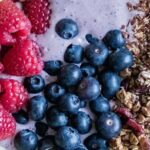
- What is the FODMAPs diet?
- Foods to avoid on the FODMAPs diet
- Foods to eat on the FODMAPs diet
- – Fruits: Bananas, blueberries, grapes, kiwi, oranges, and strawberries.
- – Grains: Gluten-free breads and cereals, rice, quinoa, and oats.
- – Proteins: Meat, poultry, fish, eggs, and tofu.
- Benefits of the FODMAPs diet
- Potential drawbacks of the FODMAPs diet
- Tips for following the FODMAPs diet
- Conclusion:
What is the FODMAPs diet?
The FODMAPs diet is a dietary approach that aims to help people manage digestive symptoms associated with irritable bowel syndrome (IBS). FODMAPs is an acronym that stands for fermentable oligosaccharides, disaccharides, monosaccharides, and polyols. These are types of carbohydrates that are poorly absorbed by the small intestine, leading to fermentation in the large intestine and the production of gas, which can cause bloating, abdominal pain, and diarrhea in people with IBS.
The FODMAPs diet involves restricting or eliminating high FODMAPs foods from the diet for a period of time, usually 2-6 weeks, and then gradually reintroducing them to determine which ones trigger symptoms. The diet is not a weight loss program, but rather a way to manage IBS symptoms.
Foods to avoid on the FODMAPs diet
The FODMAPs diet involves avoiding or limiting foods that are high in FODMAPs. Some examples of high FODMAPs foods include:
- Oligosaccharides: Wheat, rye, onions, garlic, legumes (such as beans, lentils, and chickpeas), and some fruits (such as apples, pears, and watermelon).
- Disaccharides: Lactose-containing foods, such as milk, yogurt, and soft cheeses.
- Monosaccharides: Fructose-containing foods, such as honey, high fructose corn syrup, and some fruits (such as mangoes, figs, and dates).
- Polyols: Sugar alcohols, such as sorbitol, mannitol, xylitol, and erythritol, which are often found in sugar-free gums and candies, as well as some fruits (such as avocados, cherries, and peaches).
Foods to eat on the FODMAPs diet
While the FODMAPs diet restricts many high FODMAPs foods, there are still many foods that are allowed on the diet. Some examples of low FODMAPs foods include:
– Vegetables: Carrots, cucumbers, lettuce, spinach, zucchini, and tomatoes.
– Fruits: Bananas, blueberries, grapes, kiwi, oranges, and strawberries.
– Grains: Gluten-free breads and cereals, rice, quinoa, and oats.
– Proteins: Meat, poultry, fish, eggs, and tofu.
- Dairy alternatives: Lactose-free milk and yogurt, as well as non-dairy milks such as almond, coconut, and soy milk.
Benefits of the FODMAPs diet
The FODMAPs diet has been shown to be an effective way to manage IBS symptoms in many people. Studies have found that up to 75% of people with IBS experience relief of symptoms such as bloating, abdominal pain, and diarrhea when following the diet.
In addition to symptom relief, the FODMAPs diet may also have other health benefits. For example, it may improve gut health by reducing inflammation and promoting the growth of beneficial gut bacteria. It may also improve overall quality of life by reducing the impact of IBS symptoms on daily activities.
Potential drawbacks of the FODMAPs diet
While the FODMAPs diet can be effective for managing IBS symptoms, it is not without potential drawbacks. Some people may find the diet difficult to follow, as it requires strict adherence to a list of restricted foods. Additionally, the diet may lead to nutrient deficiencies if not followed properly, as many high FODMAPs foods are also good sources of important nutrients.
It is important to work with a healthcare professional or registered dietitian when following the FODMAPs diet to ensure that nutrient needs are being met and to monitor for any potential side effects.
Tips for following the FODMAPs diet
If you are considering following the FODMAPs diet, here are some tips to help you get started:
- Work with a healthcare professional or registered dietitian to develop a personalized plan that meets your individual needs.
- Keep a food diary to help identify which foods trigger your symptoms.
- Learn to read food labels and ingredient lists to identify high FODMAPs foods.
- Experiment with low FODMAPs recipes and meal ideas to keep your diet varied and interesting.
- Stay hydrated and aim to eat a balanced diet that includes a variety of nutrient-dense foods.
Conclusion:
The FODMAPs diet can be a helpful tool for managing IBS symptoms and improving overall gut health. By avoiding or limiting high FODMAPs foods and gradually reintroducing them to identify triggers, many people with IBS can experience relief of symptoms such as bloating, abdominal pain, and diarrhea. However, it is important to work with a healthcare professional or registered dietitian when following the diet to ensure that nutrient needs are being met and to monitor for any potential side effects.






